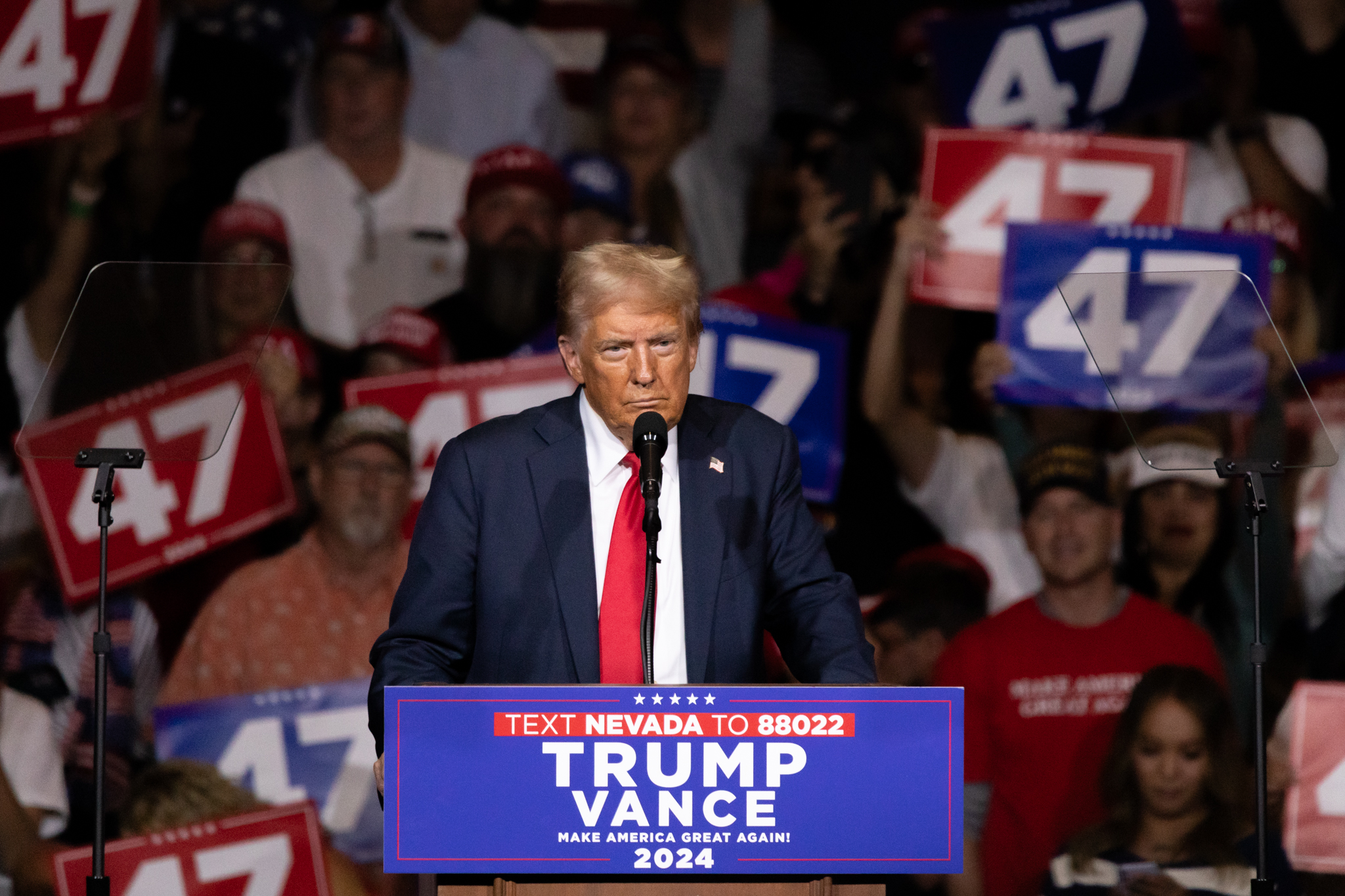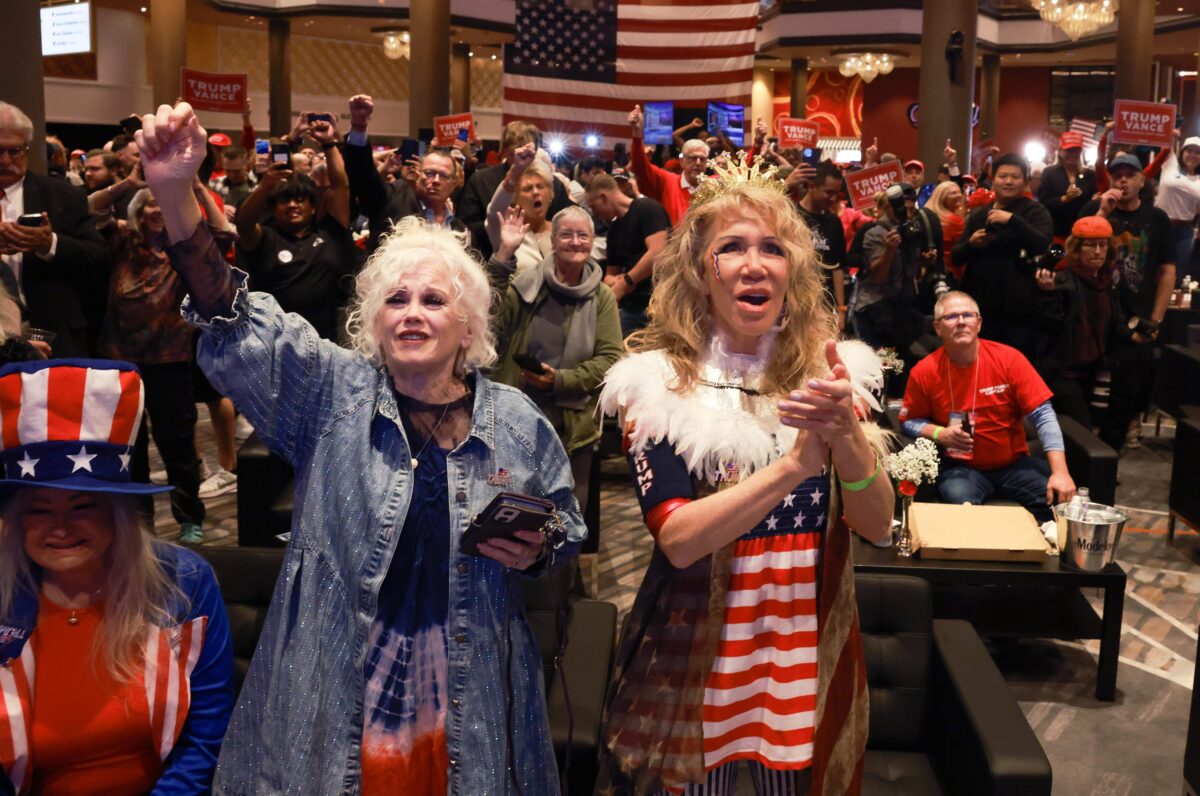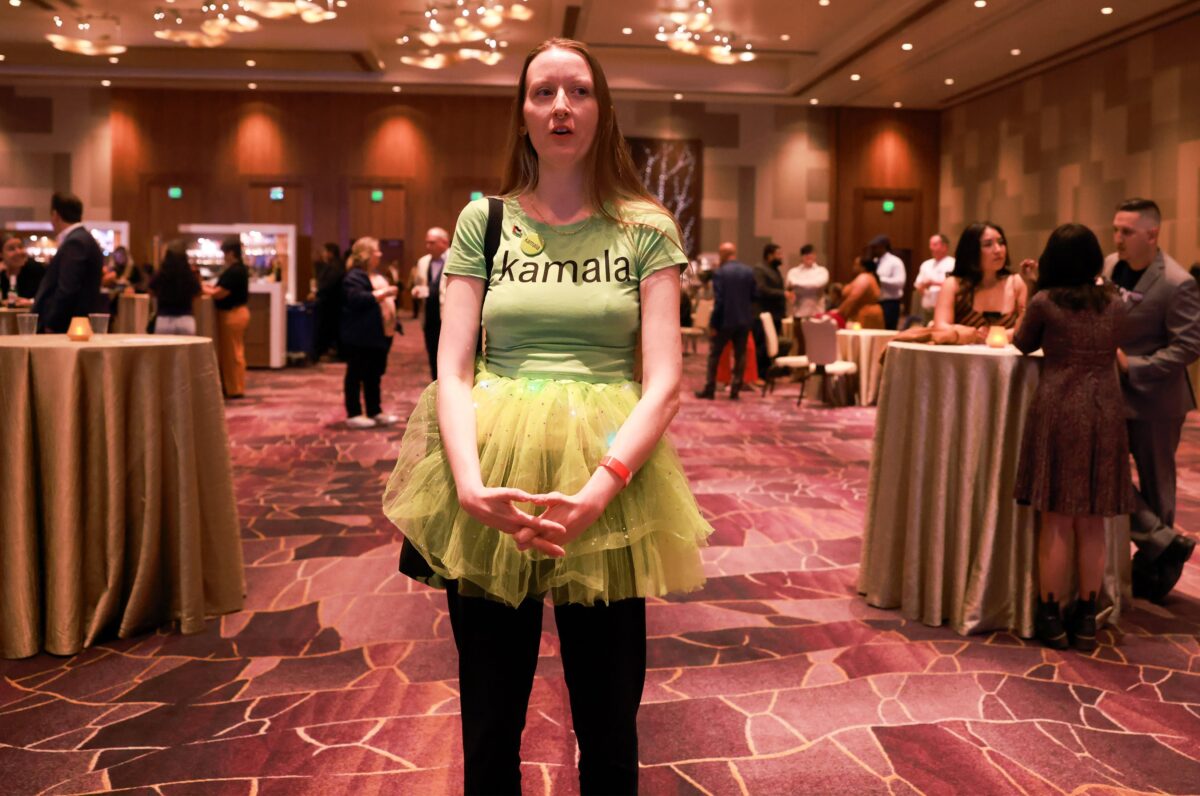Trump wins Nevada, delivering Silver State to Republicans for first time in 20 years

Former President Donald Trump has won Nevada’s six electoral votes, becoming the first Republican to win the state in two decades and riding a wave of discontent over the economy and an embrace of voting methods that Nevada Republicans have previously eschewed.
Nevada, with its six electoral votes, proved not to be a decider — Trump appears to have swept the seven swing states, with races called for him in all but Michigan and Arizona, where he currently leads.
Despite losing his prior two attempts in 2016 and 2020 — by margins of about 2.5 percent both times — Trump, bolstered by strong turnout among registered Republicans and the erosion of Democrats’ traditional advantage in populous Clark County, finally won the Silver State on his third try.
(Click here to see full results.)
The race against Vice President Kamala Harris was seen as a dead heat in the Silver State, and while the final margin is yet to be decided, Trump appears to have won relatively comfortably. While Harris leads in Clark County, Trump’s performance in the populous vote center — he is currently behind by less than 1 percent — appears to be Republicans’ strongest in recent memory. Republicans had been optimistic about their chances in the past couple of weeks, buoyed by strong early voting and mail voting turnout after the party finally embraced the legal voting methods after years of casting doubt on their reliability.
Trump’s victory was also bolstered by high turnout in Nevada’s 15 rural counties, which are heavily Republican and offset Harris’ marginal lead in Clark County. And he leads in Washoe County — typically a bellwether — by about 2.5 percent points. By comparison, Biden won the county in 2020 by 4.5 percent.
Though counting in the state still continues, Trump’s margin of victory stands at close to 5 percent. Even though there are outstanding mail votes in Clark County, Harris will not be able to make up the deficit, given the size of Trump’s lead.
After the initial ballot dump of just over 1 million votes, the race was too close to call, with Trump leading by 2.7 percentage points. But as more votes trickled in from rural counties — where Trump dominated — and new results from Clark and Washoe came in, it became clear that Harris was not seeing the margins in the state’s urban areas that she would need to overcome Trump’s lead. Instead, they grew.
The Trump victory represents an exciting moment for Nevada Republicans. Nevada GOP chair Michael McDonald, who has supported Trump through all three of his presidential runs and even attempted to overturn the 2020 election on his behalf, congratulated the former president.
“It has been an honor of my life to be by your side since 2015,” McDonald wrote on X. “This has been one hell of a ride.”

Throughout the cycle, Trump made frequent appearances to Nevada, with most of his rallies featuring his freewheeling style of hurling insults, doubling down on anti-immigrant rhetoric and mixing anecdotes with vague policy proposals, such as slashing energy bills in half within a year or immediately ending the war between Russia and Ukraine. However, at a Las Vegas rally in June, he made a notable pledge to end taxes on tipped wages, an effort to win over the state’s thousands of hospitality workers, and Harris followed suit months later.
Despite the Harris campaign’s significant financial advantage — Democrats outspent Republicans in the presidential race in Nevada by a more than 2-to-1 margin — Trump campaign officials were confident that the fundamentals of the race favored them. Nevada has persistently had the highest unemployment rate in the country throughout Biden’s term, a trend of rising housing costs exacerbated by the pandemic and continual voter frustration over inflation.
The Trump campaign also believed that his message would resonate more with voters of color — particularly Latino men — in the majority-minority state than it had in elections past.
Though Democrats have traditionally benefited from a superior ground game — and this cycle was no exception, with the mighty Culinary Workers Union Local 226 knocking over 900,000 doors — Nevada Republicans had been increasingly encouraged by election results since 2020. Nevada was the only state where Democratic President Joe Biden won but did not improve on 2016 candidate Hillary Clinton’s margins; the percentage of college-educated voters — among Democrats’ best-performing demographic groups — is lower in Nevada than any other swing state.
And with a Trump sweep of the swing states likely, it appears that strong Democratic ground games — in Nevada and elsewhere — were not the salve that Democrats were hoping it would be.
And the Trump campaign and state surrogates fully embraced early voting, encouraging Republicans to “bank [their votes]” early, which helped the party build a significant lead as a majority of votes poured in in the pre-Election Day period.
Republican Gov. Joe Lombardo’s 2022 victory, despite the low turnout, provided a pathway for Republican statewide wins — keep the Democratic margin of victory in populous Clark County low, keep Washoe County competitive if not win it outright and run up the score in the red rural areas. Trump replicated that formula — and appears to have overperformed Lombardo’s 1.5 percent victory, a function of much higher turnout and improvement in Clark County.
Trump’s victory was propelled by a surge in the share of voters who are registered as Republicans since his defeat by about 33,000 votes four years ago. At the time, Democrats had a roughly 5 percentage point registration advantage that has since fallen to less than a percentage point. A plurality of the 2024 electorate is now registered as nonpartisan, a result of the state’s implementation of automatic voter registration in 2020, with the default option being nonpartisan.
While it is unclear exactly how registered nonpartisans split their votes, Democrats’ confidence that the nonpartisan population leaned Democratic appears to have been unfounded. Given registered Republicans’ turnout advantage in the pre-Election Day voting period, Harris would have needed to win nonpartisans to be competitive in the state. With more than 1.26 million votes in and Trump leading by nearly 5 percent, it’s clear that independents did not break for Harris by any meaningful margin.
Overall, Nevada proved a signifier of Trump’s performance around the country. His improvements relative to 2020 were not concentrated in any one region, be it the Southwest or swing states as a whole. He’s on track to win the popular vote as well — a feat that, like winning Nevada, no Republican had done since 2004.
— Gabby Birenbaum and Eric Neugeboren, 8:15 a.m. 11/6/2024
Nevada still too close to call as Trump closes in on presidency
Nevadans are going to bed on election night without knowing which presidential candidate won the state’s six electoral votes — though the state’s eventual result will not decide the presidency.
The race between Vice President Kamala Harris and former President Donald Trump is too close to call as of midnight on Election Day, with nearly 1.1 million votes reported. Currently, Trump holds a lead of 5 percentage points, with numerous Election Day votes and late-arriving mail ballots, including those dropped off today, yet to be tabulated.
(Click here to see full results.)
Even though several news outlets declared Trump the winner of the presidency Tuesday evening, the results of Nevada’s presidential contest will determine whether he will sweep all seven battleground states, as he is expected to carry the remaining six. When Trump won in 2016, he carried all of this year’s battlegrounds, save for Nevada.
Meanwhile, Republicans have gained control of the U.S. Senate, but Sen. Jacky Rosen (D-NV) is locked in a tight battle against Republican Sam Brown, who is underperforming Trump so far, particularly in Washoe County.
That means the only undecided federal chamber is the U.S. House, where two of the three Democrat-held seats in Nevada remain too close to call, and Rep. Steven Horsford (D-NV) prevailed handily in the 4th District, which includes parts of Clark County and rural Nevada.

Since Harris first entered the race in July, polling between the two has remained neck and neck, with neither candidate able to establish a lead large enough to predict the winner. Both candidates invested significant time and resources into the state.
Trump changed the policy terrain in Las Vegas in June when he pledged to end taxation on tips; Harris followed with her own proposal to end taxes on tips and raise the minimum wage in Las Vegas in August. Trump personally appeared at roundtables and rallies to shore up support among Latino Americans and Asian Americans and Pacific Islanders, while Harris and her running mate, Minnesota Gov. Tim Walz, made several visits to the state, and big-name surrogates including former presidents Barack Obama and Bill Clinton were on hand during early voting to underscore its importance.
Both candidates had dueling stops Oct. 31 in Las Vegas and Reno, making their closing arguments to Nevada voters. Voters were inundated with ads from each campaign on every medium; the Harris campaign even lit up the Sphere.
Tuesday night’s results reinforce just how close the race is — in Nevada, at least.
Turnout currently stands at about 1.1 million. In 2020, Nevada saw record turnout of more than 1.4 million votes. With figures about mail ballots turned in on Election Day unavailable, turnout for this year is difficult to predict.
With the race too close to call, the winner will likely be decided based on mail ballots that trickle in after Election Day. Republicans unsuccessfully sued to block the counting of these mail ballots, which can be received until Saturday, as well as non-postmarked mail ballots that come in by 5 p.m. Friday.
In 2022, about 6 percent of Clark County and 3 percent of Washoe County votes were received after Election Day, though it is unclear how many votes are outstanding this year given that presidential elections tend to have much higher turnout.
Trump is attempting to be the first Republican to win a presidential race in Nevada since George W. Bush in 2004. Since then, Democrats have been able to win through building a significant enough firewall in Clark County, where 70 percent of voters live, to counteract Republican vote totals in swingy Washoe County and the ruby-red rural counties.
That formula has been threatened this cycle by a diminishing voter registration advantage. On Election Day 2020, Democrats had a voter registration advantage of about 5 percentage points; in 2024, it was down to 1 percent.
In Clark County, which President Joe Biden won by 9 percentage points, Democrats’ voter registration edge by Election Day was down to less than 7 percentage points.
But rather than representing Republican gains, the biggest change in voter registration dynamics has been an explosion in nonpartisan registration — bolstered by the state’s 2020 implementation of automatic voter registration.
Trump’s path to victory in the state is to ensure, as has occurred in past cycles, that Republicans turn out at higher rates than Democrats, while Harris needs to win independent voters by a significant enough margin to overcome the weakening of the Clark County Democratic firewall.
In the roughly 1 million votes included in the initial batch of results, Trump maintained a roughly 4 percentage point advantage over Harris — similar to the turnout lead held by registered Republicans over registered Democrats across those same votes. It indicates that nonpartisans have, so far, split evenly among the two candidates.
In trying to win nonpartisan voters, the Harris campaign relied on Democrats’ traditional organizing strength in Nevada — the Reid Machine mix of union canvassers, state party officials, campaign organizers and interest groups whose impressive ground game has delivered the state to Democrats in the past. To that effect, the mighty Culinary Workers’ Union Local 226 has knocked more than 900,000 doors this cycle.
Trump, meanwhile, has banked on economic dissatisfaction in a state that has the highest unemployment rate in the nation, and gains among voters of color — in particular, Latino men.
Both campaigns have spent enormous sums of money to get their message out to voters — about $122 million in total. Democrats have significantly outspent Republicans in the presidential race, between the Harris campaign itself and allied outside groups. Harris-aligned spending has totaled about $85 million, while Trump and his affiliates have thrown in nearly $36 million.
While the election is still too close to call in Nevada, the state did not end up mattering to either candidate’s path to 270 votes.
In the U.S. Senate, however, it will determine the size of the Republican majority. Having flipped Democratic seats in Ohio and West Virginia, Republicans will now have control of the upper chamber.
Races in five swing states — including Nevada — are still too close to call. Republican Sam Brown has a lead of less than half a percentage point — meaning Rosen is outrunning Harris.
— Gabby Birenbaum and Eric Neugeboren, 11:55 p.m. 11/5/2024

